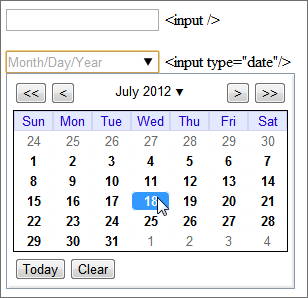Let the Browser Handle the Datepicker (if it can)
I built a simple data entry app a while back and took the opportunity to try out a lot of neat new things in the web world. This included using Modernizr to detect native date picker support shipping in some browsers.
Traditionally, I’d just toss a Javascript date picker like the one from the excellent jQuery UI library when needed but now that browsers are starting to support other input types, e.g. <input type="date"/>, it’s possible to use the JS pickers as a fallback.
This idea isn’t novel with me, of course. I first saw it in one of Scott Hanselman’s talks (I can’t find a link at the moment, but I did find another MS blogger that does pretty much the same thing in great detail). If what I present below is too light on detail, go read his post.
Here’s how I did it in my ASP.NET MVC project:
First, create an editor template to render DateTime properties:
// in Views/Shared/EditorTemplates/DateTime.cshtml
@model DateTime?
@{
var value = (Model != null && Model != DateTime.MinValue)
? Model.Value.ToString("yyyy-MM-dd")
: "";
}
@Html.TextBox("", value, new { type = "date" })
Now whenever you call “EditorFor” with a DateTime in a view, it will use that EditorTemplate to render it. If you’ve been using “EditorFor” all along, you’re in good shape.
Then the only other thing you need is to attach a datepicker if the browser needs it. I dropped this into my global scripts file, which runs on every single page:
// attach the jquery datepicker unless the current browser has one
if (!Modernizr.inputtypes.date) {
$("input[type=date]").datepicker();
}
The theory here is that now when a browser adds support for native datepickers, the site will automatically stop adding the jQuery datepicker. Slick.
Here’s an example. If you try this in Chrome (added sometime on or before version 20…?), the second input should be a native datepicker:

Oh, and by the way, this is especially great for mobile devices—this is supported on iOS but not much else (yet).
